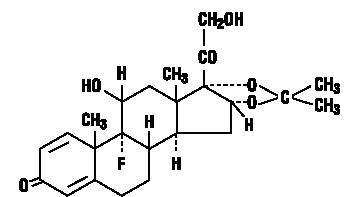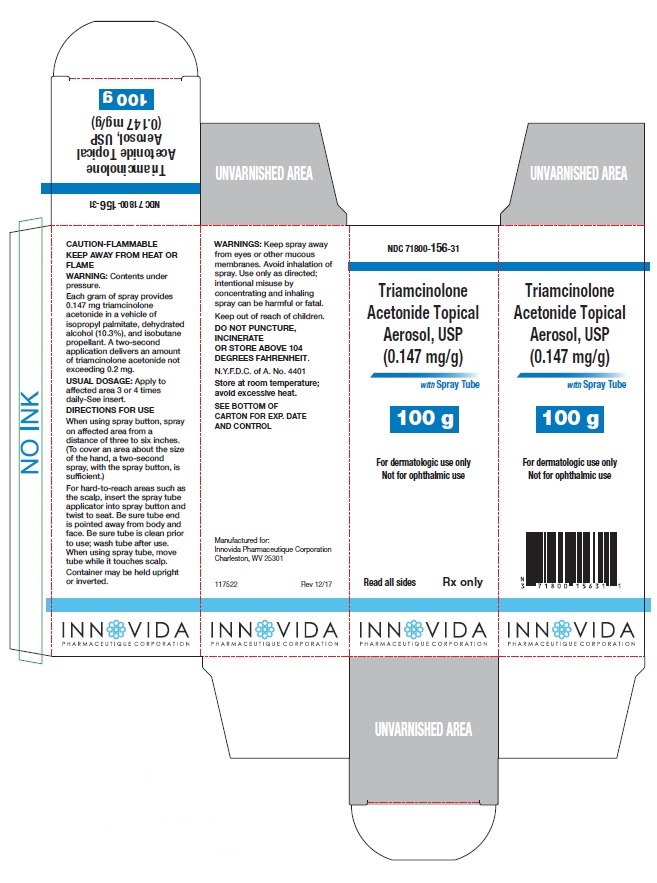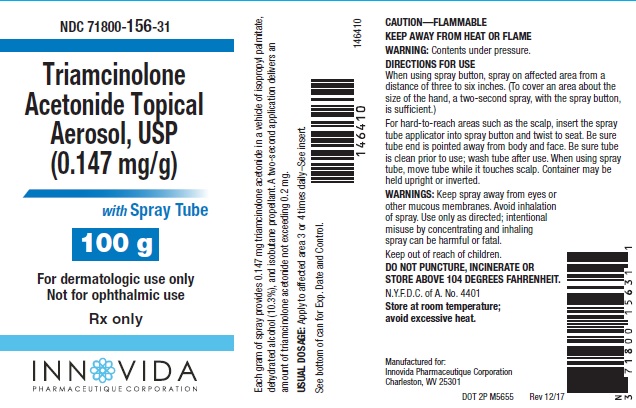TRIAMCINOLONE ACETONIDE aerosol, spray
Triamcinolone Acetonide by
Drug Labeling and Warnings
Triamcinolone Acetonide by is a Prescription medication manufactured, distributed, or labeled by Innovida Pharmaceutique Corporation, DPT Laboratories, Ltd.. Drug facts, warnings, and ingredients follow.
Drug Details [pdf]
-
DESCRIPTION
The topical corticosteroids constitute a class of primarily synthetic steroids used as anti-inflammatory and antipruritic agents. The steroids in this class include triamcinolone acetonide. Triamcinolone acetonide is designated chemically as 9-fluoro-11β, 16α, 17, 21-tetrahydroxypregna-1, 4-diene-3, 20-dione cyclic 16, 17-acetal with acetone. The structural formula is:
A two-second application, which covers an area approximately the size of the hand, delivers an amount of triamcinolone acetonide not exceeding 0.2 mg. After spraying, the nonvolatile vehicle remaining on the skin contains approximately 0.2% triamcinolone acetonide. Each gram of spray provides 0.147 mg triamcinolone acetonide in a vehicle of isopropyl palmitate, dehydrated alcohol (10.3%), and isobutane propellant.
-
CLINICAL PHARMACOLOGY
Topical corticosteroids share anti-inflammatory, antipruritic and vasoconstrictive actions.
The mechanism of anti-inflammatory activity of the topical corticosteroids is unclear. Various laboratory methods, including vasoconstrictor assays, are used to compare and predict potencies and/or clinical efficacies of the topical corticosteroids. There is some evidence to suggest that a recognizable correlation exists between vasoconstrictor potency and therapeutic efficacy in man.
Pharmacokinetics
The extent of percutaneous absorption of topical corticosteroids is determined by many factors including the vehicle, the integrity of the epidermal barrier, and the use of occlusive dressings.
Topical corticosteroids can be absorbed from normal intact skin. Inflammation and/or other disease processes in the skin increase percutaneous absorption.
Once absorbed through the skin, topical corticosteroids are handled through pharmacokinetic pathways similar to systemically administered corticosteroids. Corticosteroids are bound to plasma proteins in varying degrees. Corticosteroids are metabolized primarily in the liver and are then excreted by the kidneys. Some of the topical corticosteroids and their metabolites are also excreted into the bile.
- INDICATIONS AND USAGE
- CONTRAINDICATIONS
-
PRECAUTIONS
General
Systemic absorption of topical corticosteroids has produced reversible hypothalamic-pituitary-adrenal (HPA) axis suppression, manifestations of Cushing’s syndrome, hyperglycemia, and glucosuria in some patients.
Conditions which augment systemic absorption include the application of the more potent steroids, use over large surface areas, prolonged use, and the addition of occlusive dressings.
Therefore, patients receiving a large dose of any potent topical steroid applied to a large surface area or under an occlusive dressing should be evaluated periodically for evidence of HPA axis suppression by using the urinary free cortisol and ACTH stimulation tests, and for impairment of thermal homeostasis. If HPA axis suppression or elevation of the body temperature occurs, an attempt should be made to withdraw the drug, to reduce the frequency of application, substitute a less potent steroid, or use a sequential approach.
Recovery of HPA axis function and thermal homeostasis are generally prompt and complete upon discontinuation of the drug. Infrequently, signs and symptoms of steroid withdrawal may occur, requiring supplemental systemic corticosteroids.
Children may absorb proportionally larger amounts of topical corticosteroids and thus be more susceptible to systemic toxicity (see PRECAUTIONS, Pediatric Use).
If irritation develops, topical corticosteroids should be discontinued and appropriate therapy instituted.
In the presence of dermatological infections, the use of an appropriate antifungal or antibacterial agent should be instituted. If a favorable response does not occur promptly, the corticosteroid should be discontinued until the infection has been adequately controlled.
Information for the Patient
Patients using triamcinolone acetonide topical aerosol, USP should receive the following information and instructions:
- 1. This medication is to be used as directed by the physician. It is for external use only; avoid contact with the eyes and inhalation of the spray.
- 2. Patients should be advised not to use this medication for any disorder other than for which it was prescribed.
- 3. The treated skin area should not be bandaged or otherwise covered or wrapped as to be occlusive unless directed by the physician.
- 4. Patients should report any signs of local adverse reactions.
- 5. Parents of pediatric patients should be advised not to use tight-fitting diapers or plastic pants on a child being treated in the diaper area, as these garments may constitute occlusive dressings.
- 6. Do not use triamcinolone acetonide topical aerosol, USP on the underarms or groin areas unless directed by your physician.
- 7. If no improvement is seen within 2 weeks, contact your physician.
- 8. Do not use other corticosteroid-containing products while using triamcinolone acetonide topical aerosol, USP without first consulting your physician.
- 9. Triamcinolone acetonide topical aerosol, USP is flammable. Avoid heat, flames or smoking when applying triamcinolone acetonide topical aerosol, USP.
Laboratory Tests
A urinary free cortisol test and ACTH stimulation test may be helpful in evaluating HPA axis suppression.
Carcinogenesis, Mutagenesis, Impairment of Fertility
Long-term animal studies have not been performed to evaluate the carcinogenic potential or the effect on fertility of topical corticosteroids.
Studies to determine mutagenicity with prednisolone and hydrocortisone showed negative results.
Pregnancy: Teratogenic Effects
Corticosteroids are generally teratogenic in laboratory animals when administered systemically at relatively low dosage levels. The more potent corticosteroids have been shown to be teratogenic after dermal application in laboratory animals. There are no adequate and well-controlled studies in pregnant women on teratogenic effects from topically applied corticosteroids. Therefore, topical corticosteroids should be used during pregnancy only if the potential benefit justifies the potential risk to the fetus. Drugs of this class should not be used extensively on pregnant patients, in large amounts, or for prolonged periods of time.
Nursing Mothers
It is not known whether topical administration of corticosteroids could result in sufficient systemic absorption to produce detectable quantities in breast milk. Systemically administered corticosteroids are secreted into breast milk in quantities not likely to have a deleterious effect on the infant. Nevertheless, caution should be exercised when topical corticosteroids are administered to a nursing woman.
Pediatric Use
Pediatric patients may demonstrate greater susceptibility to topical corticosteroid-induced HPA axis suppression and Cushing’s syndrome than mature patients because of a larger skin surface area to body weight ratio.
HPA axis suppression, Cushing’s syndrome, and intracranial hypertension have been reported in children receiving topical corticosteroids. Manifestations of adrenal suppression in children include linear growth retardation, delayed weight gain, low plasma cortisol levels, and absence of response to ACTH stimulation. Manifestations of intracranial hypertension include bulging fontanelles, headaches, and bilateral papilledema.
Administration of topical corticosteroids to children should be limited to the least amount compatible with an effective therapeutic regimen. Chronic corticosteroid therapy may interfere with the growth and development of children.
-
ADVERSE REACTIONS
The following local adverse reactions are reported infrequently with topical corticosteroids, but may occur more frequently with the use of occlusive dressings (reactions are listed in an approximate decreasing order of occurrence): burning, itching, irritation, dryness, folliculitis, hypertrichosis, acneiform eruptions, hypopigmentation, perioral dermatitis, allergic contact dermatitis, maceration of the skin, secondary infection, skin atrophy, striae, and miliaria.
-
OVERDOSAGE
Topically applied corticosteroids can be absorbed in sufficient amounts to produce systemic effects (see PRECAUTIONS, General).
-
DOSAGE AND ADMINISTRATION
Directions for use of the spray can are provided on the label. The preparation may be applied to any area of the body, but when it is sprayed about the face, care should be taken to see that the eyes are covered, and that inhalation of the spray is avoided.
Spray is flammable; avoid heat, flame or smoking when using this product.
Three or four applications daily of triamcinolone acetonide topical aerosol are generally adequate.
-
HOW SUPPLIED
Triamcinolone acetonide topical aerosol, USP is a clear, colorless liquid that is practically free from visible impurities. It has an odor characteristic of ethanol. It is supplied as follows:
100 g (NDC: 71800-156-31) aerosol can.
Storage and Handling
Store at room temperature; avoid excessive heat. Contents under pressure; do not puncture or incinerate. Keep out of reach of children.
To report SUSPECTED ADVERSE REACTIONS, contact the FDA at 1-800-FDA-1088 or www.fda.gov/medwatch.
Manufactured for:
Innovida Pharmaceutique Corporation
Charleston, WV 25301
Revised May 2018
- Package/Label Display Panel
- Package/Label Display Panel
-
INGREDIENTS AND APPEARANCE
TRIAMCINOLONE ACETONIDE
triamcinolone acetonide aerosol, sprayProduct Information Product Type HUMAN PRESCRIPTION DRUG Item Code (Source) NDC: 71800-156 Route of Administration TOPICAL Active Ingredient/Active Moiety Ingredient Name Basis of Strength Strength TRIAMCINOLONE ACETONIDE (UNII: F446C597KA) (TRIAMCINOLONE ACETONIDE - UNII:F446C597KA) TRIAMCINOLONE ACETONIDE 0.147 mg in 1 g Inactive Ingredients Ingredient Name Strength ISOPROPYL PALMITATE (UNII: 8CRQ2TH63M) ISOBUTANE (UNII: BXR49TP611) ALCOHOL (UNII: 3K9958V90M) Packaging # Item Code Package Description Marketing Start Date Marketing End Date 1 NDC: 71800-156-31 100 g in 1 CAN; Type 0: Not a Combination Product 01/15/2018 Marketing Information Marketing Category Application Number or Monograph Citation Marketing Start Date Marketing End Date NDA NDA012104 01/15/2018 Labeler - Innovida Pharmaceutique Corporation (080892908) Establishment Name Address ID/FEI Business Operations DPT Laboratories, Ltd. 832224526 MANUFACTURE(71800-156)
© 2025 FDA.report
This site is not affiliated with or endorsed by the FDA.


